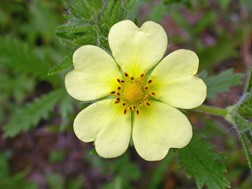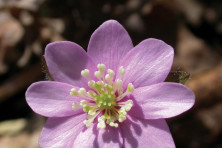August Wildflowers
- Share
- Tweet
- Pin
- Share
Late August is one of my favorite wildflower times. Admittedly some of the plants I’m calling wildflowers would without question be referred to as weeds by plenty of people. They’re still flowers and grow wild. Naturally as soon as these plants begin competing with agricultural crops or garden vegetables they fall into the weed category – call them what you wish.
Every so often we come across some beautiful color combinations of roadside plants. A favorite now includes blue of Chicory, yellow of Sow Thistle and white of Queen Anne’s Lace. By the way, I will present an interesting challenge to the many fine artists in Door County ranging from amateur to professional. Collect a few Chicory stems including the blue flowers, keep them fresh in some water, and proceed to use whatever medium you wish to copy one of the blossoms so that your rendition is very true to color.
A number of years ago Charlotte wrote a poem about several of the roadside flowers and decorated the margins of the paper with pictures of the blossoms, done with colored pencils. She was sure that at least one in her large collection would be a perfect match to the blue. Not so! It turned out to be the most difficult flower to accurately portray. She will be eager to hear from some of you.
By the way, it soon becomes apparent when driving on some of our county roads or highways that many of the late August wildflowers, including those mentioned above, virtually line the shoulders as though they had been purposely planted there. Yes, machines, including county snowplows, graders and mowers, have unintentionally planted them there.
The so-called weeds in question produce countless seeds that begin the process. The blades of the machines scrape the roadsides, thereby removing any and all competing plant life and then proceed to plant the seeds, virtually grinding them into the ground. Now rainfall provides them with water and the plants are “off to the races,” nature’s garden planted by humans. Provide seeds with disturbed soil, lack of competition, water and sunlight and the resulting plants will soon color the landscape year after year.

An appropriate name for the Sulphur Cinquefoil might be the “heart flower.”
One of the most prolific weeds mentioned above, the Queen Anne’s Lace, has a look-alike that has become especially abundant in recent years in northeastern Door County, the Burnet Saxifrage, known by relatively few people. There are fields and roadsides choked full of them, for example in the County ZZ region. I’ve found plenty heading southward toward Baileys Harbor along County Q. The composite flower head of the Burnet Saxifrage is more open and delicate than that of the Queen Anne’s Lace, and the basal leaves are parsley-like compared to the finely cut carrot-like foliage of the Queen Anne’s lace. These two plants often grow intermingled with one another.
There are so many yellow wildflowers in bloom in late summer, far outnumbering other colors, and I’d like to know why this is so. We drive past a cherry orchard near our place to see countless yellow and orange Butter and Eggs wildflowers decorating the ground in the aisles between the rows of trees. Dandelions provide the yellow in early summer.
Goldenrods have already begun to bloom, a few such as the Canada Goldenrod growing in large sprawling patches being very weedy while some of the others, including the ZigZag and Gray, never become widespread. The Dune and Ohio Goldenrods, for example, happen to be quite rare in the state. I’m keeping track of one of several Giant Goldenrods, Solidago gigantea, growing near our house that now measures about six feet tall. What a beauty. There is little wonder why years ago some gardeners in England, who virtually invented the term “master gardener,” actually imported a few tall goldenrod species from America to use as background plants in their spectacular gardens. (By the way, goldenrods have absolutely nothing to do with causing hay fever. That culprit happens to mainly be the ragweed.)
Today I examined a planting of beautiful small-flowered Maximillian Sunflowers, given to us years ago by Carl Scholz, which grow near the edge of our fallow field west of our garden shed. These perennials are not quite ready to flower but in a summer of plentiful rain, unlike this year, they can grow upwards of six or more feet tall. In full blossom nearby grow a few dozen Yellow Coneflowers, another easy-to-grow favorite perennial of ours.

A meadow decorated with Yellow Coneflowers in August is a beautiful sight.
A highly visible roadside flower, the small yellow Bird’s-foot Trefoil is about as brilliant yellow as any of the many other yellow-flowered plants. Unfortunately it is spreading more than I’d like it to, even having taken to the area north of our house, far from any roadside, which I mow only once or twice a summer. Your guess is as good as mine as to how it got there, perhaps planted by birds.
There is an introduced and naturalized yellow wildflower of roadsides and fallow fields, the Sulphur or Rough-fruited Cinquefoil, Potentilla recta, which generally grows singly and never becomes an invasive problem. Its heart-shaped petals make it an instant favorite of some people. Call it the “heart flower” if you wish. Knowing the real name of a flower doesn’t make it smell better or more beautiful to look at!

